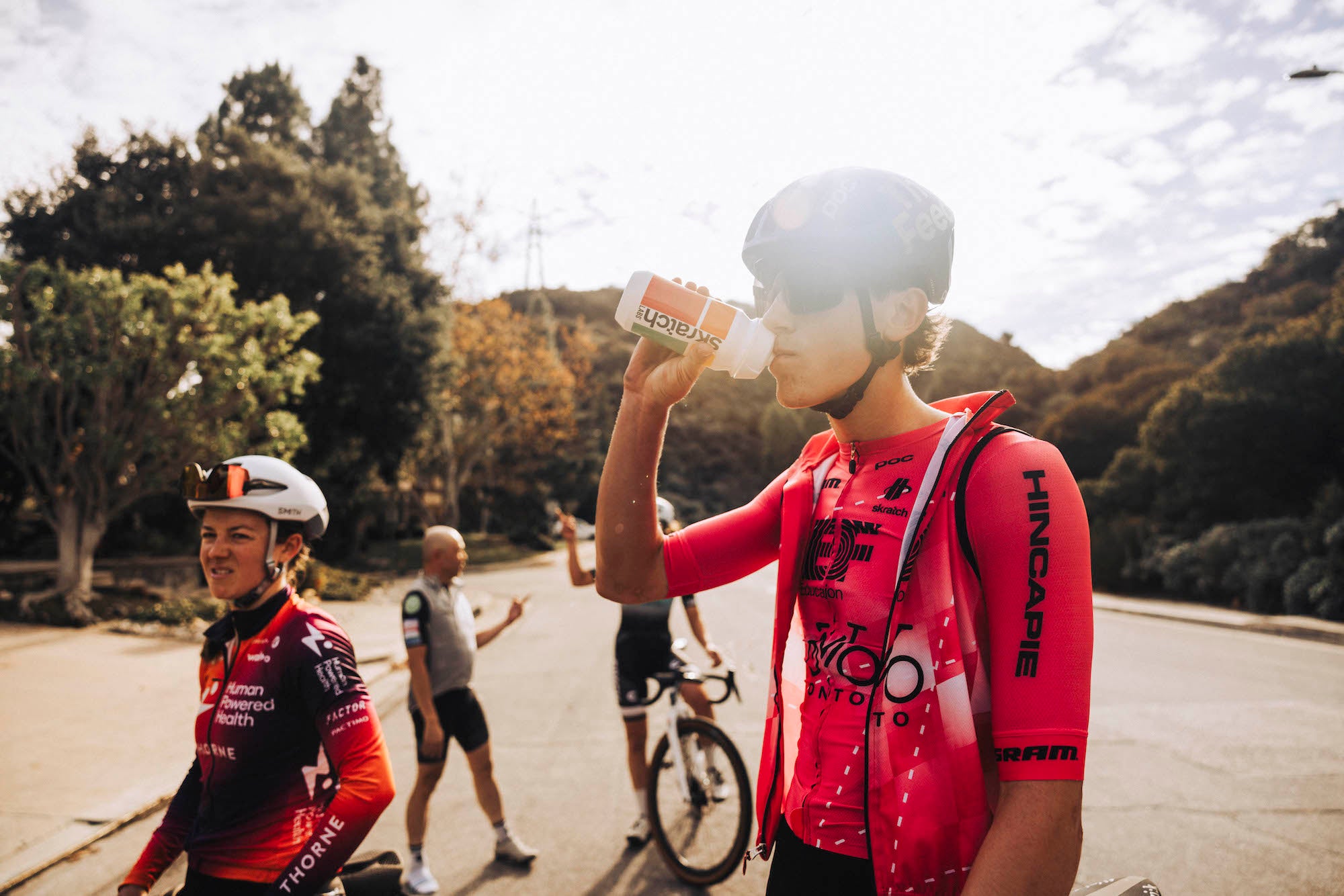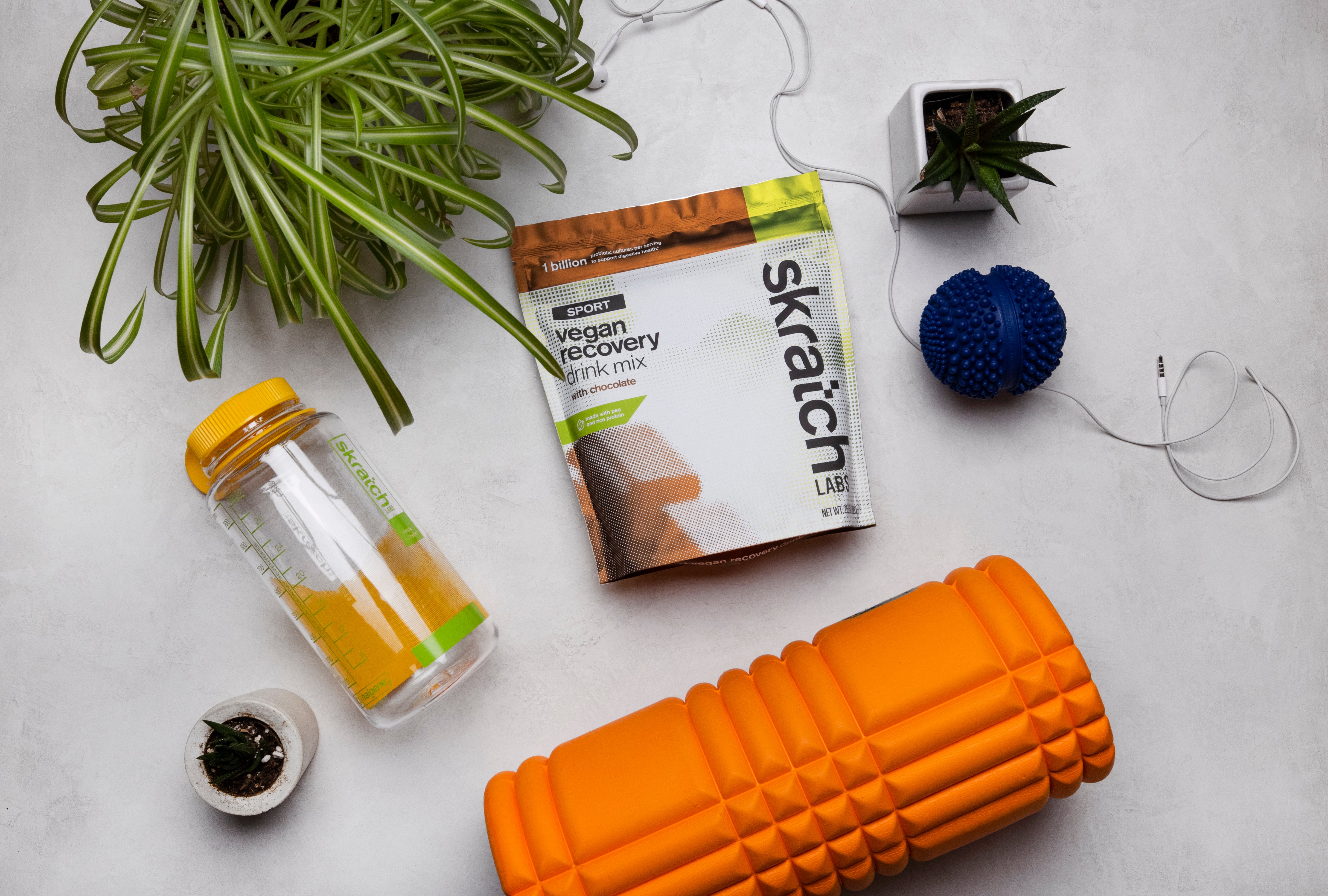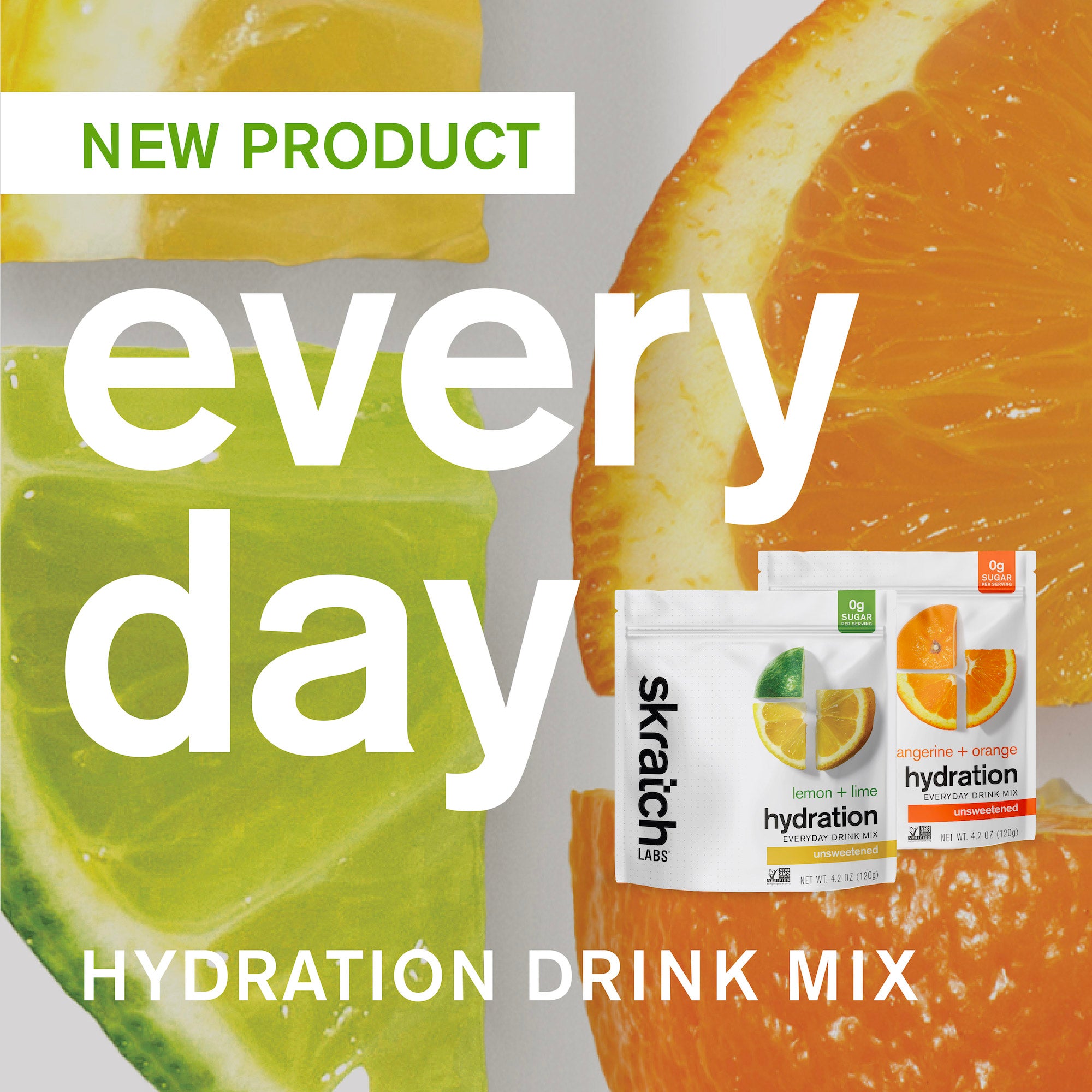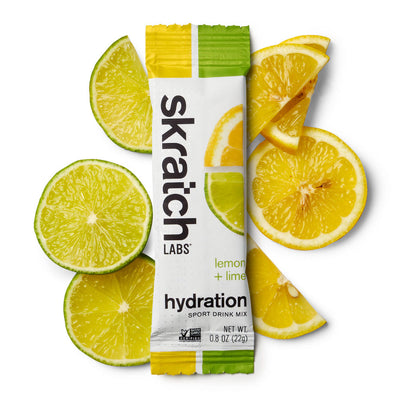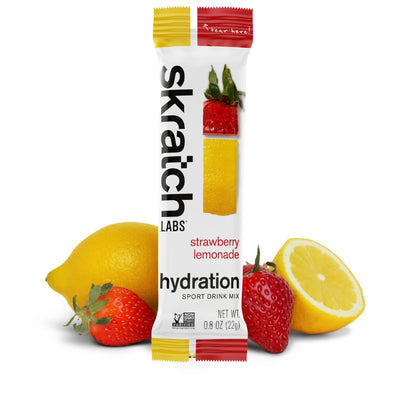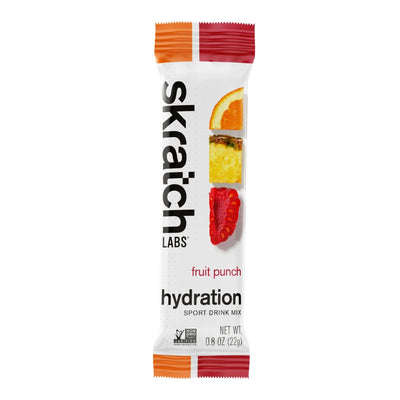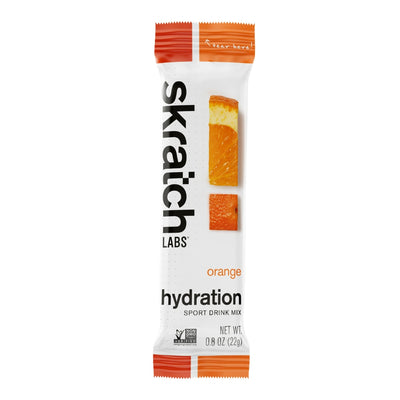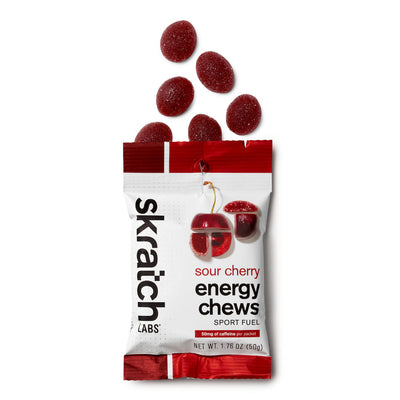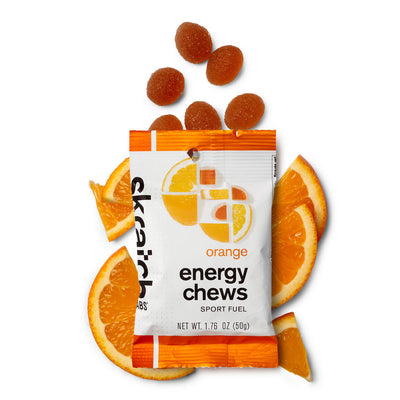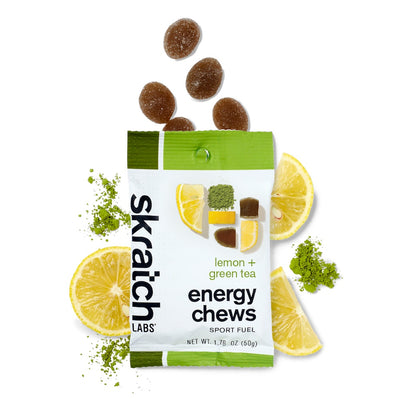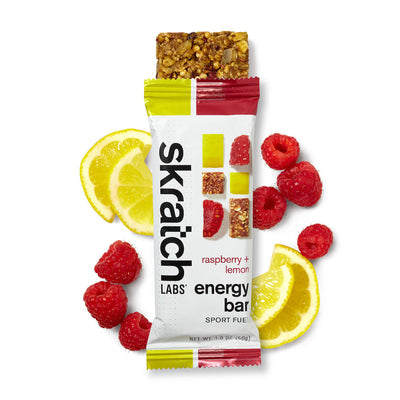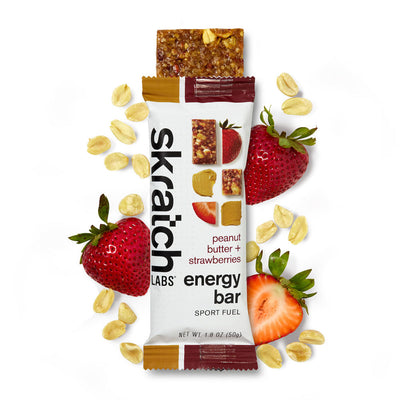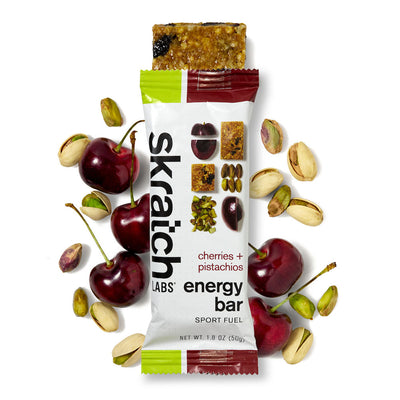What is Matcha Green Tea? Why is it in a Sports Drink?

At Skratch Labs, all of our hydration products are driven by science but crafted and sold as real food, not as supplements. While it’s a subtle distinction for some, it’s a fundamental difference that defines everything we do. For example, we are meticulous about the formula in our Sport Hydration Mix, making sure that we have an electrolyte ratio that best matches what we lose in sweat and a blend of sugars that optimizes absorption in the small intestine to prevent gastrointestinal distress (i.e., gut rot). At the same time, none of our drink mixes contain flavoring agents or artificial ingredients. Instead, we use whole functional foods that have been dried and crushed like raspberries, oranges, lemons, mangos, and pineapples to flavor and enrich our line. This gives all of our drinks a simple and clean taste that hydrates us while also providing the nutritional benefits associated with the foods we use. Most recently, we took this a step further by developing a flavor using Matcha – a type of green tea that is consumed whole rather than brewed, making it convenient and incredibly nutrient dense compared to other teas.
Like many plant-based foods, tea is a functional food. A functional food contains essential nutrients like carbohydrate, fat, protein, vitamins, and minerals as well as biologically active compounds that affect one’s physiology and that can contribute to disease prevention (Hayat, 2013; Deldicque, 2008). The natural compounds in foods that are not essential nutrients but that are important to our health are referred to as phytochemicals or phytonutrients. Phytochemicals in turn have a broad and complex classification system that has generated a litany of jargon in the marketing and science surrounding functional foods as well as an equivalent amount of confusion when it comes to understanding what we are actually consuming and whether it’s actually good for us.
For now, I’ll skip out on describing all of the classes of phytochemicals but mention the ones that are more common and relevant to tea. For example, one class of phytochemicals are alkaloids that include caffeine and caffeine-like compounds like theobromine and theophylline found in tea, coffee, and cocoa. Another class of phytochemicals are polyphenols which are further categorized into non-flavonoids and flavonoid compounds. Non-flavonoids include compounds like reseveratrol common to grapes and wine while flavonoids include compounds like anthocyanins, quercitin, and tanins, which can be further classified into catechins or flavan-3-ols. It’s these catechins that are specifically found in high quantities in tea and which can be further broken down into four major types of catechins in tea including epigallocatechin-3-gallate (EGCG), epigallocatechin (EGC), epicatechin-3-gallate (ECG), andepicatechin (EC) that are the compounds that impart many of the health benefits associated with tea (Kim, 2014).
While all of these names are confusing all by themselves, the confusion is often confounded because when people describe a particular phytochemical, it’s common to use the different names within a particular class as synonyms for one another. For example, EGCG can be described as a catechin. A catechin can be described as a tannin. A tannin can be described as a flavonoid. A flavonoid can be described as a polyphenol. And finally, a polyphenol can be described as a phytochemical. To keep things easy and coming full circle, we’ll just describe good things in food that aren’t essential nutrients as phytonutrients and only talk about specific compound like the caffeine or EGCG in tea when appropriate.
With that in mind, the reason that phytonutrients in tea, specifically, catechins like EGCG have physiological significance and a number of health benefits is because they have an incredible array of unique attributes that include anti-oxidative (Jowko, 2011; Panza, 2008), anti-inflammatory (Hagiwara, 2014; Haramizu, 2013; Nicod, 2014), anti-carcinogenic (Sato, 1999; Siddiqui, 2014), anti-hypertensive (Khalesi, 2014; Mousavi, 2013; Onakypoya, 2014), anti-microbial (Hagiwara, 2014; Lin, 2014; Pang, 2014), neuro-protective (Noguchi-Shinohara, 2014), DNA protective (Ho, 2014), cholesterol lowering (Eichenberger, 2009; Kono 1996; Onakypoya, 2014; Yousaf, 2014), and thermogenic or metabolism increasing properties (Hodgson, 2013; Jeukendrup, 2011). And ultimately, all of these things are good things, especially when reviewing the wide array of research studies describing health benefits for specific diseases like cardiovascular disease (Ghanbari, 2014; Santesso, 2014), cancer (Butt, 2013; Green, 2014; Greenberg, 2013; Huang, 2014; Inoue, 1998; Wang, 2014), urinary tract infections (Katz, 2014), type II diabetes (Pham, 2014; Venables, 2008), arthritis (Byun, 2014; Yang, 2014; Riegsecker, 2013), stroke (Nabavi, 2014), obesity (Byun, 2014), dental diseases (Gaur, 2014), neurodegenerative diseases like Parkinson’s (Qi, 2014; Gao, 2013; Albarracin, 2012; Tanaka, 2011), and dermatological issues (Scheinfeld, 2013; Pazyar, 2012).
Beyond these disease preventing properties, tea also can act as a stimulant due to naturally occurring caffeine as well as an amino acid called L-theanine, which has been show to be a mood stabilizer, working synergistically with caffeine to improve focus (Yoto, 2014; Camfield, 2014; Ross. 2014; Giesbrecht, 2010). And while much has been made about caffeine as a performance enhancer due to its ability to mobilize free fatty acids (Jeukendrup, 2011), improve alertness (Beaven, 2013), and enhance glycogen re-synthesis (Beelen, 2012; Taylor, 2011) it’s also clear that those effects only come at high doses of caffeine (3-6 mg per kg of body weight) and are better if you are unaccustomed to caffeine (Burke, 2008; Ganio, 2009; Deldicque, 2008). In addition, it’s also clear that at very high doses, caffeine can have negative affects ranging from sleep disturbance to anxiety to cardiovascular complications (Youngstedt, 1998, 2000; Rogers, 2013; Chrysant, 2014).
From an exercise standpoint, there’s less evidence that phytonutrients beyond caffeine like catechins in tea are beneficial to actual performance. That said, some studies in mice have shown improved endurance capacity in mice associated with EGCG supplementation resulting from an increase in fat use (Murase, 2005) as well as less of an age related decline in endurance performance (Murase, 2008). Interestingly, one in vitro (outside of the body) study has shown that EGCG can help prevent muscle wasting (Mirza, 2014) which may have implications for humans during exercise or in recovery from exercise, though those implications may be a bit of a stretch, especially since actual benefits in exercising humans are unclear. For example, a single 640 mg dose of EGCG in soccer players showed no reduction in oxidative stress or muscle damage (Jowko, 2012). An acute dose of green tea catechins (22 mg per kg of body weight), however, immediately after exercise in Tae Kwon did show improvements in immune function (Lin, 2014). Finally, in one human study, short term consumption (945 mg over 48 hours) of EGCG has been shown to increase maximal oxygen consumption without changes in cardiac output, hinting a greater ability of muscle to extract oxygen (Richards, 2010). Unfortunately, much more research is needed to bear out any real world performance benefits.

That all said, we weren’t just thinking about the potential health or performance benefits of tea when we developed our newest Sport Hydration Mix that contains Matcha – a type of green tea. For what it’s worth, like many people, we just like tea. We like the way it tastes and how it makes us feel. Unfortunately, we don’t always have the time or resources to brew it. This is where Matcha comes in. Like all other teas, Matcha comes from the plant Camillia Sinensis. There are three basic types of tea – green, oolong, and black tea. They’re distinguished by whether the plants are allowed to ferment before drying. Green tea is unfermented, oolong is partially fermented and black tea is fermented. The fermentation process changes the amount of phytonutrients available. For example, black tea is higher in caffeine than green or oolong, but green tea is higher in catechins like EGCG than either oolong or black tea. Unlike other teas, Matcha is unique because it’s grown in the shade, significantly increasing its chlorophyll content—the component in plants that make them green and that may also add to the positive health benefits of tea (Jiang, 2013). In addition, Matcha is not brewed. Instead, the entire leaf is ground into a powder and consumed whole. Because the entire leaf is consumed, this increases the amount of phytonutrients that can be consumed and concentrated into a drink, compared to brewed tea. But most importantly, because Matcha is a powder it’s actually possible to blend it into a drink mix making it a convenient and highly functional ingredient.

A single 16 oz serving of our Sport Hydration Mix with Matcha + Lemons contains about 500 mg of whole ground Matcha. Traditionally, if someone were making a 16 oz serving of Matcha tea, they might use about 2000 mg or a teaspoon of whole Matcha powder. So per serving we’re about a quarter of a typical serving of Matcha that someone might traditionally consume. The reason we did this is that our assumption is that during prolonged exercise someone might consume multiple servings of our Sport Hydration Mix and we wanted to make sure that people didn’t over-consume Matcha relative to what’s traditionally consumed. In addition, this helps to keep the overall flavor profile light and prevents the overly tannic taste profile that is common when drinking Matcha and other teas. This also means that the amount of caffeine per serving is lower at approximately 16 mg per 16 oz serving. As a point of reference an 8 oz cup of coffee might have anywhere from 70-100 mg of caffeine whereas a typical 8 oz cup of Matcha tea might have about 30-40 mg of caffeine. While the amount of caffeine in our Sport Hydration Mix with Matcha + Lemons is not high, it is there and it is natural with 5 servings equaling a cup of coffee. Over the course of a long day, this small amount can add up if someone is consuming enough to keep hydrated, which is the ultimate purpose of our line of Sport Hydration mixes.
Although it’s nice to know that teas, in particular, green teas like Matcha have a host of potential health benefits (Hayat, 2013), it’s unlikely that a single drink of anything is likely to improve performance or health (Jowko, 2012; Randell, 2013). The reality is that we never intended nor do we think that our Sport Hydration Mix with Matcha + Lemons is, by itself, a panacea for poor health or performance. Like all things in life, it’s important to always look at the big picture when thinking about one’s well being. That picture includes one’s overall diet, physical activity, stress level, social support, sleep and innumerable other factors spread over a lifetime. Ultimately, what we believe is that using whole food ingredients with known functional benefits is just better than the common practice of using artificial ingredients like coloring agents, emulsifiers, and synthetic sweeteners that may actually be harmful to our health (Simmons, 2014). By using Matcha we don’t just get a functional food, we get an incredible and refreshing taste that helps to encourage drinking and that keeps us hydrated with all of the potential upsides of real tea.

References:
1. Albarracin, S. L., Stab, B., Casas, Z., Sutachan, J. J., Samudio, I., Gonzalez, J. et al. (2012). Effects of natural antioxidants in neurodegenerative disease. Nutr Neurosci, 15(1), 1-9.
2. Beaven, C. M., & Ekstrom, J. (2013). A comparison of blue light and caffeine effects on cognitive function and alertness in humans. PLoS One, 8(10), e76707.
3. Beelen, M., Kranenburg, J., Senden, J. M., Kuipers, H., & Loon, L. J. (2012). Impact of caffeine and protein on postexercise muscle glycogen synthesis. Med Sci Sports Exerc, 44(4), 692-700.
4. Burke, L. M. (2008). Caffeine and sports performance. Appl Physiol Nutr Metab, 33(6), 1319-1334.
5. Butt, M. S., Ahmad, R. S., Sultan, M. T., Nasir Qayyum, M. M., & Naz, A. (2013). Green tea and anticancer perspectives: Updates from last decade. Crit Rev Food Sci Nutr.
6. Byun, J. K., Yoon, B. Y., Jhun, J. Y., Oh, H. J., Kim, E. K., Min, J. K. et al. (2014). Epigallocatechin-3-gallate ameliorates both obesity and autoinflammatory arthritis aggravated by obesity by altering the balance among CD4+ T-cell subsets. Immunol Lett, 157(1-2), 51-59.
7. Camfield, D. A., Stough, C., Farrimond, J., & Scholey, A. B. (2014). Acute effects of tea constituents L-theanine, caffeine, and epigallocatechin gallate on cognitive function and mood: a systematic review and meta-analysis. Nutr Rev, 72(8), 507-522.
8. Chrysant, S. G., & Chrysant, G. S. (2014). Cardiovascular complications from consumption of high energy drinks: recent evidence. J Hum Hypertens.
9. Deldicque, L., & Francaux, M. (2008). Functional food for exercise performance: fact or foe? Curr Opin Clin Nutr Metab Care, 11(6), 774-781.
10. Eichenberger, P., Colombani, P. C., & Mettler, S. (2009). Effects of 3-week consumption of green tea extracts on whole-body metabolism during cycling exercise in endurance-trained men. Int J Vitam Nutr Res, 79(1), 24-33.
11. Ganio, M. S., Klau, J. F., Casa, D. J., Armstrong, L. E., & Maresh, C. M. (2009). Effect of caffeine on sport-specific endurance performance: a systematic review. J Strength Cond Res, 23(1), 315-324.
12. Gao, X., Cassidy, A., Schwarzschild, M. A., Rimm, E. B., & Ascherio, A. (2012). Habitual intake of dietary flavonoids and risk of Parkinson disease. Neurology, 78(15), 1138-1145.
13. Gaur, S., & Agnihotri, R. (2014). Green tea: a novel functional food for the oral health of older adults. Geriatr Gerontol Int, 14(2), 238-250.
14. Ghanbari, B., Khaleghparast, S., Ghadrdoost, B., & Bakhshandeh, H. (2014). Nutritional status and coronary artery disease: a cross sectional study. Iran Red Crescent Med J, 16(3), e13841.
15. Giesbrecht, T., Rycroft, J. A., Rowson, M. J., & De Bruin, E. A. (2010). The combination of L-theanine and caffeine improves cognitive performance and increases subjective alertness. Nutr Neurosci, 13(6), 283-290.
16. Green, C. J., de Dauwe, P., Boyle, T., Tabatabaei, S. M., Fritschi, L., & Heyworth, J. S. (2014). Tea, coffee, and milk consumption and colorectal cancer risk. J Epidemiol, 24(2), 146-153.
17. Greenberg, A. K., Tsay, J. C., Tchou-Wong, K. M., Jorgensen, A., & Rom, W. N. (2013). Chemoprevention of lung cancer: prospects and disappointments in human clinical trials. Cancers (Basel), 5(1), 131-148.
18. Hagiwara, M., & Matsushita, K. (2014). Epigallocatechin gallate suppresses LPS endocytosis and nitric oxide production by reducing Rab5-caveolin-1 interaction. Biomed Res, 35(2), 145-151.
19. Haramizu, S., Ota, N., Hase, T., & Murase, T. (2013). Catechins suppress muscle inflammation and hasten performance recovery after exercise. Med Sci Sports Exerc, 45(9), 1694-1702.
20. Hayat, K., Iqbal, H., Malik, U., Bilal, U., & Mushtaq, S. (2013). Tea and its consumption: benefits and risks. Crit Rev Food Sci Nutr.
21. Ho, C. K., Choi, S. W., Siu, P. M., & Benzie, I. F. (2014). Effects of single dose and regular intake of green tea (Camellia sinensis) on DNA damage, DNA repair, and heme oxygenase-1 expression in a randomized controlled human supplementation study. Mol Nutr Food Res, 58(6), 1379-1383.
22. Hodgson, A. B., Randell, R. K., Boon, N., Garczarek, U., Mela, D. J., Jeukendrup, A. E. et al. (2013). Metabolic response to green tea extract during rest and moderate-intensity exercise. J Nutr Biochem, 24(1), 325-334.
23. Huang, C. C., Lee, W. T., Tsai, S. T., Ou, C. Y., Lo, H. I., Wong, T. Y. et al. (2014). Tea consumption and risk of head and neck cancer. PLoS One, 9(5), e96507.
24. Inoue, M., Tajima, K., Hirose, K., Hamajima, N., Takezaki, T., Kuroishi, T. et al. (1998). Tea and coffee consumption and the risk of digestive tract cancers: data from a comparative case-referent study in Japan. Cancer Causes Control, 9(2), 209-216.
25. Jeukendrup, A. E., & Randell, R. (2011). Fat burners: nutrition supplements that increase fat metabolism. Obes Rev, 12(10), 841-851.
26. Jiang, H., & Xiao, J. B. (2013). A review on the structure-function relationship aspect of polysaccharides from tea materials. Crit Rev Food Sci Nutr.
27. Jowko, E., Sacharuk, J., Balasinska, B., Ostaszewski, P., Charmas, M., & Charmas, R. (2011). Green tea extract supplementation gives protection against exercise-induced oxidative damage in healthy men. Nutr Res, 31(11), 813-821.
28. Jowko, E., Sacharuk, J., Balasinska, B., Wilczak, J., Charmas, M., Ostaszewski, P. et al. (2012). Effect of a single dose of green tea polyphenols on the blood markers of exercise-induced oxidative stress in soccer players. Int J Sport Nutr Exerc Metab, 22(6), 486-496.
29. Katz, A., Efros, M., Kaminetsky, J., Herrlinger, K., Chirouzes, D., & Ceddia, M. (2014). A green and black tea extract benefits urological health in men with lower urinary tract symptoms. Ther Adv Urol, 6(3), 89-96.
30. Khalesi, S., Sun, J., Buys, N., Jamshidi, A., Nikbakht-Nasrabadi, E., & Khosravi-Boroujeni, H. (2014). Green tea catechins and blood pressure: a systematic review and meta-analysis of randomised controlled trials. Eur J Nutr.
31. Kim, H. S., Quon, M. J., & Kim, J. A. (2014). New insights into the mechanisms of polyphenols beyond antioxidant properties; lessons from the green tea polyphenol, epigallocatechin 3-gallate. Redox Biol, 2, 187-195.
32. Kono, S., Shinchi, K., Wakabayashi, K., Honjo, S., Todoroki, I., Sakurai, Y. et al. (1996). Relation of green tea consumption to serum lipids and lipoproteins in Japanese men. J Epidemiol, 6(3), 128-133.
33. Lin, S. P., Li, C. Y., Suzuki, K., Chang, C. K., Chou, K. M., & Fang, S. H. (2014). Green tea consumption after intense taekwondo training enhances salivary defense factors and antibacterial capacity. PLoS One, 9(1), e87580.
34. Mirza, K. A., Pereira, S. L., Edens, N. K., & Tisdale, M. J. (2014). Attenuation of muscle wasting in murine CC myotubes by epigallocatechin-3-gallate. J Cachexia Sarcopenia Muscle.
35. Mousavi, A., Vafa, M., Neyestani, T., Khamseh, M., & Hoseini, F. (2013). The effects of green tea consumption on metabolic and anthropometric indices in patients with Type 2 diabetes. J Res Med Sci, 18(12), 1080-1086.
36. Murase, T., Haramizu, S., Ota, N., & Hase, T. (2008). Tea catechin ingestion combined with habitual exercise suppresses the aging-associated decline in physical performance in senescence-accelerated mice. Am J Physiol Regul Integr Comp Physiol, 295(1), R281-R289.
37. Murase, T., Haramizu, S., Shimotoyodome, A., Nagasawa, A., & Tokimitsu, I. (2005). Green tea extract improves endurance capacity and increases muscle lipid oxidation in mice. Am J Physiol Regul Integr Comp Physiol, 288(3), R708-R715.
38. Nabavi, S. M., Daglia, M., Moghaddam, A. H., Nabavi, S. F., & Curti, V. (2014). Tea Consumption and Risk of Ischemic Stroke: a Brief Review of the Literature. Curr Pharm Biotechnol.
39. Nicod, N., Chiva-Blanch, G., Giordano, E., Davalos, A., Parker, R. S., & Visioli, F. (2014). Green tea, cocoa, and red wine polyphenols moderately modulate intestinal inflammation and do not increase high-density lipoprotein (HDL) production. J Agric Food Chem, 62(10), 2228-2232.
40. Noguchi-Shinohara, M., Yuki, S., Dohmoto, C., Ikeda, Y., Samuraki, M., Iwasa, K. et al. (2014). Consumption of green tea, but not black tea or coffee, is associated with reduced risk of cognitive decline. PLoS One, 9(5), e96013.
41. Onakpoya, I., Spencer, E., Heneghan, C., & Thompson, M. (2014). The effect of green tea on blood pressure and lipid profile: A systematic review and meta-analysis of randomized clinical trials. Nutr Metab Cardiovasc Dis.
42. Pang, J. Y., Zhao, K. J., Wang, J. B., Ma, Z. J., & Xiao, X. H. (2014). Green tea polyphenol, epigallocatechin-3-gallate, possesses the antiviral activity necessary to fight against the hepatitis B virus replication in vitro. J Zhejiang Univ Sci B, 15(6), 533-539.
43. Panza, V. S., Wazlawik, E., Ricardo Schutz, G., Comin, L., Hecht, K. C., & da Silva, E. L. (2008). Consumption of green tea favorably affects oxidative stress markers in weight-trained men. Nutrition, 24(5), 433-442.
44. Pazyar, N., Feily, A., & Kazerouni, A. (2012). Green tea in dermatology. Skinmed, 10(6), 352-355.
45. Pham, N. M., Nanri, A., Kochi, T., Kuwahara, K., Tsuruoka, H., Kurotani, K. et al. (2014). Coffee and green tea consumption is associated with insulin resistance in Japanese adults. Metabolism, 63(3), 400-408.
46. Qi, H., & Li, S. (2014). Dose-response meta-analysis on coffee, tea and caffeine consumption with risk of Parkinson’s disease. Geriatr Gerontol Int, 14(2), 430-439.
47. Randell, R. K., Hodgson, A. B., Lotito, S. B., Jacobs, D. M., Boon, N., Mela, D. J. et al. (2013). No effect of 1 or 7 d of green tea extract ingestion on fat oxidation during exercise. Med Sci Sports Exerc, 45(5), 883-891.
48. Richards, J. C., Lonac, M. C., Johnson, T. K., Schweder, M. M., & Bell, C. (2010). Epigallocatechin-3-gallate increases maximal oxygen uptake in adult humans. Med Sci Sports Exerc, 42(4), 739-744.
49. Riegsecker, S., Wiczynski, D., Kaplan, M. J., & Ahmed, S. (2013). Potential benefits of green tea polyphenol EGCG in the prevention and treatment of vascular inflammation in rheumatoid arthritis. Life Sci, 93(8), 307-312.
50. Rogers, P. J., Heatherley, S. V., Mullings, E. L., & Smith, J. E. (2013). Faster but not smarter: effects of caffeine and caffeine withdrawal on alertness and performance. Psychopharmacology (Berl), 226(2), 229-240.
51. Ross, S. M. (2014). L-theanine (suntheanin): effects of L-theanine, an amino acid derived from Camellia sinensis (green tea), on stress response parameters. Holist Nurs Pract, 28(1), 65-68.
52. Santesso, N., & Manheimer, E. (2014). A summary of a cochrane review: green and black tea for the primary prevention of cardiovascular disease. Glob Adv Health Med, 3(2), 66-67.
53. Sato, D. (1999). Inhibition of urinary bladder tumors induced by N-butyl-N-(4-hydroxybutyl)-nitrosamine in rats by green tea. Int J Urol, 6(2), 93-99.
54. Scheinfeld, N. (2013). Update on the treatment of genital warts. Dermatol Online J, 19(6), 18559.
55. Siddiqui, I. A., Bharali, D. J., Nihal, M., Adhami, V. M., Khan, N., Chamcheu, J. C. et al. (2014). Excellent anti-proliferative and pro-apoptotic effects of (-)-epigallocatechin-3-gallate encapsulated in chitosan nanoparticles on human melanoma cell growth both in vitro and in vivo. Nanomedicine.
56. Simmons, A. L., Schlezinger, J. J., & Corkey, B. E. (2014). What Are We Putting in Our Food That Is Making Us Fat? Food Additives, Contaminants, and Other Putative Contributors to Obesity. Curr Obes Rep, 3(2), 273-285.
57. Tanaka, K., Miyake, Y., Fukushima, W., Sasaki, S., Kiyohara, C., Tsuboi, Y. et al. (2011). Intake of Japanese and Chinese teas reduces risk of Parkinson’s disease. Parkinsonism Relat Disord, 17(6), 446-450.
58. Taylor, C., Higham, D., Close, G. L., & Morton, J. P. (2011). The effect of adding caffeine to postexercise carbohydrate feeding on subsequent high-intensity interval-running capacity compared with carbohydrate alone. Int J Sport Nutr Exerc Metab, 21(5), 410-416.
59. Venables, M. C., Hulston, C. J., Cox, H. R., & Jeukendrup, A. E. (2008). Green tea extract ingestion, fat oxidation, and glucose tolerance in healthy humans. Am J Clin Nutr, 87(3), 778-784.
60. Wang, W., Yang, Y., Zhang, W., & Wu, W. (2014). Association of tea consumption and the risk of oral cancer: a meta-analysis. Oral Oncol, 50(4), 276-281.
61. Yang, E. J., Lee, J., Lee, S. Y., Kim, E. K., Moon, Y. M., Jung, Y. O. et al. (2014). EGCG attenuates autoimmune arthritis by inhibition of STAT3 and HIF-1alpha with Th17/Treg control. PLoS One, 9(2), e86062.
62. Yoto, A., Murao, S., Nakamura, Y., & Yokogoshi, H. (2014). Intake of green tea inhibited increase of salivary chromogranin A after mental task stress loads. J Physiol Anthropol, 33(1), 20.
63. Youngstedt, S. D., O’Connor, P. J., Crabbe, J. B., & Dishman, R. K. (1998). Acute exercise reduces caffeine-induced anxiogenesis. Med Sci Sports Exerc, 30(5), 740-745.
64. Youngstedt, S. D., O’Connor, P. J., Crabbe, J. B., & Dishman, R. K. (2000). The influence of acute exercise on sleep following high caffeine intake. Physiol Behav, 68(4), 563-570.
65. Yousaf, S., Butt, M. S., Suleria, H. A., & Iqbal, M. J. (2014). The role of green tea extract and powder in mitigating metabolic syndromes with special reference to hyperglycemia and hypercholesterolemia. Food Funct, 5(3), 545-556.


